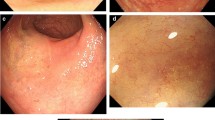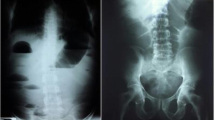Abstract
Purpose
Chronic infection with schistosomiasis has been clearly associated with the development of bladder cancer, and infestation is associated with a high incidence of colorectal cancer in endemic populations. Despite this association, the potential role of alterations in tumor suppressor genes colorectal cancers has never been evaluated in an endemically infected population. The aim of this paper was to compare histopathologic and genetic changes in schistosomal colitis-associated colorectal cancer (SCC) with colorectal cancer in a group of patients from the same population not affected by the disease (NDCC).
Materials and methods
Sixty patients were included in this study: SCC—40, NDCC—20. Data collected included age, sex, clinical presentation, presence of synchronous tumors, histopathology, and clinical stage. p53, DCC (deleted in colorectal cancer gene), and mismatch repair genes (MLH1 and MSH2) were studied using immunohistochemical staining.
Results
Patients with SCC were significantly younger than the NDCC group (34.52±11.22 years vs 50.73±12.75 years, p=0.02). Mucinous adenocarcinoma occurred significantly more frequently in SCC (35 vs 10%, p=0.02). SCC tumors were more frequently stage III or IV, and significantly more synchronous tumors were present in the affected group (SCC—8/40 vs NDCC—1/20, p=0.05). p53 staining was far more frequent in SCC (SCC—32/40 vs NDCC—8/20, p=0.006). DCC expression was similar in two groups. There were only four cases, three in SCC and one in NDCC, that showed microsatellite instability.
Conclusion
The data suggest that schistosomal colitis is more commonly associated with earlier onset of multicentric colorectal cancer, high percentage of mucinous adenocarcinoma, and presents at an advanced stage. The identification of a higher incidence of altered p53 expression in the SCC group raises the possibility of an association between schistosomiasis and alterations in p53 activation as an inciting event in colorectal cancer development.
Similar content being viewed by others
References
Greenlee R, Hill-Harmon M, Murray T et al (2001) Cancer statistics, 2001. CA Cancer J Clin 51:15–36
Greenlee RT, Murray T, Bolden S et al (2000) Cancer statistics, 2000. CA Cancer J Clin 50(1):7–33
Heys S, O’Hanrhan T, Brittenden J et al (1994) Colorectal cancer in young patients: a review of literature. Eur J Surg Oncol 20:225–231
Mokhtar N (1991) Cancer pathology registry (1985–1989). National Cancer Institute of Cairo University. Al Asdekaa, Cairo, pp 1–5
Soliman AS, Bondy ML, Raouf AA et al (1999) Cancer mortality in Menofeia, Egypt: comparison with US mortality rates. Cancer Causes Control 10(5):349–354
Abou-El-Eneine A BF, Abdou L, Abd-El-Kader M, Gawish Y (1986) Colorectal cancer in patients under 40 years of age. Bull Alexandria Fac Med 12:1171–1178
Soliman AS, Bondy ML, Levin B et al (1997) Colorectal cancer in Egyptian patients under 40 years of age. Int J Cancer 71(1):26–30
Abou-Zeid AA, Khafagy W, Marzouk DM et al (2002) Colorectal cancer in Egypt. Dis Colon Rectum 45(9):1255–1260
Soliman AS, Bondy ML, Levin B et al (1998) Familial aggregation of colorectal cancer in Egypt. Int J Cancer 77(6):811–816
Hussein K, Aly MS, Magrath I (2000) Loss of Y chromosome in bilharzial bladder cancer. Cancer Genet Cytogenet 117:32–36
El-Rifai W, Kamel D, Larramendy ML et al (2000) DNA copy number changes in Schistosoma-associated and non-Schistosoma-associated bladder cancer. Am J Pathol 156(3):871–878
Muscheck M, Abol-Enein H, Chew K et al (2000) Comparison of genetic changes in schistosome-related transitional and squamous bladder cancers using comparative genomic hybridization. Carcinogenesis 21(9):1721–1726
Rockhill B, Giovannucci E (1999) Cancer mortality rates in Menofeia, Egypt: comparison with US mortality rates. Cancer Causes Control 10(5):345–347
Whittemore A, Wu-williams A, Lee M et al (1990) Diet, physical activity and colorectal cancer among Chinese in North America and China. J Natl Cancer Inst 82:915–926
Xu Z, Su DL (1984) Schistosoma japonicum and colorectal cancer: an epidemiological study in the People’s Republic of China. Int J Cancer 34(3):315–318
Wai-Lun L, HK C, KW C (2002) Palliation for advanced malignant colorectal obstruction by self-expanding metallic stents: a prospective evaluation of outcomes. Dis Colon Rectum 45(12):A1–A4
Ishii A, Matsuoka H, Aji T et al (1994) Parasite infection and cancer: with special emphasis on Schistosoma japonicum infections (Trematoda). A review. Mutat Res 305(2):273–281
EL-Ghoneimy E, Moustafa H, Yammini M et al (1989) Colorectal carcinoma in Egyptian patients younger than 30 years. J Egypt Natl Cancer Inst 4:95–103
Koyama Y, Kotake K (1997) Overview of colorectal cancer in Japan: report from the Registry of the Japanese Society for Cancer of the Colon and Rectum. Dis Colon Rectum 40(10 Suppl)S2–9
Chen M, Chuang C, Chang P et al (1980) Evolution of colorectal cancer in schistosomiasis. Cancer 46:1661–1675
Ninomiya K (1970) Studies on distribution of the ova of Schistosoma japonicum in organs with Schistosomiasis japonica. Kurume Med J 33:1375–1393, quoted from Matsuda K, Masaki T, Ishii S et al (1999) Possible associations of rectal carcinoma with Schistosoma japonicum infection and membranous nephropathy: a case report with a review. Jpn J Clin Oncol 29:576–581
Matsuda K, Masaki T, Ishii S et al (1999) Possible associations of rectal carcinoma with Schistosoma japonicum infection and membranous nephropathy: a case report with a review. Jpn J Clin Oncol 29(11):576–581
Oya M, Takahashi S, Okuyama T et al (2003) Synchronous colorectal carcinoma: clinico-pathological features and prognosis. Jpn J Clin Oncol 33:38–43
Gordon PH, Navratil E (1999) Surgery of anus, colon and rectum, 2nd edn. pp 575–706
Keighly M, Williams N (1999) Surgery of the anus, rectum and colon, 2nd edn. pp 990–1024
Courtney M, Townsend J, Evers M et al (2001) Sabiston textbook of surgery. The biological basis of modern surgical practice, 7th edn. pp 930–970
Greenstein A (2000) Cancer in inflammatory bowel disease. Mt Sinai J Med 67(3):227–240
Greenstein A, Slater G, Heimann T et al (1986) A comparison of multiple synchronous colorectal cancer in ulcerative colitis, familial polyposis coli, and de novo cancer. Ann Surg 203(2):123–128
Soliman AS, Bondy ML, El-Badawy SA et al (2001) Contrasting molecular pathology of colorectal carcinoma in Egyptian and Western patients. Br J Cancer 85(7):1037–1046
Schneider A, Stolte M (1993) Clinical and pathomorphological findings in patients with colorectal carcinoma complicating ulcerative colitis. Z Gastroenterol 31(3):192–197
Warren W, Biggs PJ, el-Baz M (1995) Mutations in the p53 gene in schistosomal bladder cancer: a study of 92 tumours from Egyptian patients and a comparison between mutational spectra from schistosomal and non-schistosomal urothelial tumours. Carcinogenesis 16(5):1181–1189
Balkwill F, Mantovani A (2001) Inflammation and cancer: back to Virchow? Lancet 357:539–545
Burmer G, Rabinovitch P, Haggitt R et al (1993) Neoplastic progression in ulcerative colitis: histology, DNA content, and loss of a p53 allele. Gastroenterology 103:1602–1610
Author information
Authors and Affiliations
Corresponding author
Rights and permissions
About this article
Cite this article
Madbouly, K.M., Senagore, A.J., Mukerjee, A. et al. Colorectal cancer in a population with endemic Schistosoma mansoni: is this an at-risk population?. Int J Colorectal Dis 22, 175–181 (2007). https://doi.org/10.1007/s00384-006-0144-3
Accepted:
Published:
Issue Date:
DOI: https://doi.org/10.1007/s00384-006-0144-3




